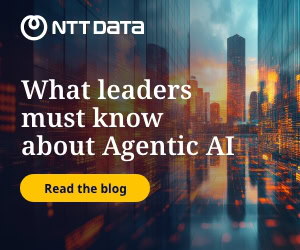Gartner predicts up to 40% of enterprise applications will include integrated task-specific agents by 2026, up from less than 5% today. It posits that adding task specialisation capabilities evolves AI assistants into AI agents. These AI agents have the capacity to operate and perform complex, end-to-end tasks.
In 2026, Southeast Asia and Hong Kong stand at a pivotal moment in the integration of agentic AI, a technology that empowers machines to make autonomous decisions.
While organisations can harness agentic AI to streamline operations and enhance customer experiences, they also face significant challenges, including ethical concerns and workforce displacement.
Leaders are racing ahead to adopt these innovations, seeking competitive advantages that promise to reshape industries. As they navigate this tipping point, the balance between opportunity and risk becomes crucial, defining the future landscape of work in the region.

Adhil Badat, managing director for Asia Pacific and Japan at Rackspace Technology, shares his perspective on how organisations are pushing forward agentic AI adoption in the quest to accelerate transformation and innovation.
Agentic AI vs traditional AI
Badat says that agentic AI "represents a major evolution in automation” with its ability to make decisions, learn from outcomes, and take actions without consistent human input.
"It requires organisations to go beyond just isolated AI experiments and really think about how they integrate AI into their business strategy," he said.
If organisations want to adopt agentic AI, Badat urges them to start by assessing their readiness in various areas, such as data, governance, infrastructure, scalability, and the existing AI platforms in use.
"It's essential to identify high-impact and achievable AI use cases, and then once you've understood the use case, to create a roadmap that balances quick wins with long-term sustainability," he emphasised.
Before scaling, Badat reminds that organisations should first have a clear understanding of their internal processes, their security requirements, and how humans would collaborate with these AI agents. Moreover, he posits that ensuring smooth implementation across systems entails having structured planning sessions, reviews, considering vendor dependencies, and integration capabilities, which also help to ensure smooth implementation across systems.
Competitive advantages and maximising ROI
Once the foundations are set, such as data, governance, and integration, the next question becomes: how can organisations turn experimentation into measurable results? For Badat, this is where competitive advantage comes in.
"Many organisations that are leading the way with AI are gaining significant competitive advantages due to early adoption, by turning their adoption into measurable impact," said Badat, noting improvements in customer experience, productive innovation, and employee productivity.
"The latest research conducted by Rackspace Technology shows that those businesses that are leading the way with AI are three times more likely to scale their AI initiatives compared to their peers, with nearly two-thirds already seeing substantial returns. They've created positive feedback loops by embedding AI very early into their business strategy and also into their operations, and that is helping them to see, you know, faster returns on their investments, and it's also helping them choose to accelerate their advantage over competitors," he shared.
For Badat,maximising the return on investment by embedding AI into core businesses requires consideration and thought about how AI is being integrated into the business strategy, and also involves moving quickly from experimentation to execution.
He said that organisations must focus on achievable use cases and think about their approaches early.
"In most cases, the organisations that are leading the way have already built the confidence, and they've already got the infrastructure in place for scaling,” he said.
Today, the real-world value of agentic AI is heavily centred around speed to value and customer experience, according to Badat.
“The agents that are deployed from an agentic AI perspective have handled tasks in areas such as customer support. Even here at Rackspace Technology, we've started to help with tasks such as HR, finance, IT, sales operations, and managing entire workflows, rather than automating isolated tasks,” he shared.
Adapting to agentic AI use
But competitive advantage is not built on technology alone. To fully capture AI’s benefits, organisations must prepare their people to work alongside autonomous systems.
The workforce must be comfortable alongside AI agents to adapt to agentic AI. Badat said this level of comfort can be practised where both humans and AI will share a responsibility for delivering an outcome.
"Skills in interpreting AI-driven recommendations, managing escalations and engaging in iterative feedback processes would be crucial, and that's where humans play a great part, because there's always going to be that ongoing feedback loop to ensure that the Agentic AI system works effectively and adjusts as it goes as an organisation changes," Badat shared.
He also urges organisations to focus on building competencies in oversight and monitoring, and to ensure the ethical use of AI as AI systems become more autonomous.
Lastly, planning for workforce enablement needs to include elements such as upskilling pathways and change management. It's for me those two in particular that are essential to ensure that organisations realise the full value of Agentic AI going forward," he advises organisations.
Measuring the success of agentic AI initiatives
Of course, adaptation is only part of the story. Organisations must also define how success is measured, ensuring that their AI investments translate into long-term business value.
For Badat, the success of agentic AI varies across different organisations, based on their vertical and industry. He reminded business leaders to define success metrics that align with their business goals.
Success measures can include efficiency gains, cost reduction, and improved throughput. What’s important, is to implement monitoring systems and feedback loops to track AI performance. The Rackspace executive said such measures can help organisations continuously improve and learn.
He also reminds organisations to establish a measurement framework that addresses concerns around governance and risk mitigation, as well as the management of integrating AI outcomes into the broader decision-making process.
"Regular assessment of AI's business value is essential to maintain momentum and guide future investments in AI capabilities," Badat reminds.
Agentic AI in 2026 and beyond
Looking ahead, Badat believes the real transformation is yet to come.
"I would say by 2026 Agentic AI is likely to evolve into something that is far more proactive, a lot more decision-oriented, and it drives more business logic through autonomous orchestration and with complex workloads built out," he predicts.
He then urges CIOs to plan for these systems to be more deeply embedded across their operations.
"CIOs must be considerate of the flexible and scalable AI environments that they would probably need to design and ensure that they are strong observability, data governance and system integration tools in place to ensure the entire ecosystem functions as expected. Investing in cross-functional alignments, things like risk frameworks, as well as ensuring that business leaders, functional leaders, operational leaders and IT operations are cohesively working or collaborating effectively to ensure that these systems are embedded, is key," he said.
Finally, Badat advises CIOs to employ iterative IT strategies to prepare themselves and help them to tap into the next evolution of agentic AI, "because it continues to evolve once it's deployed”.
Click on the PodChats player to hear Badat discuss how leaders are accelerating agentic AI adoption in 2026:
- How does agentic AI differ from traditional AI?
- What is the connection between robotic process automation (RPA) and agentic AI?
- What preparations are necessary for adopting agentic AI?
- What competitive advantages do AI leaders currently enjoy?
- Referring to the Rackspace report, The AI Acceleration Gap: Why Some Enterprises Are Surging Ahead, how will the 250% surge in AI investments affect scalability?
- In 2025, CFOs we spoke to are demanding greater transparency and accountability when it comes to technology investments. What strategies are AI leaders using to maximise RoAI (return on AI investments)?
- Speaking of use cases, in your experience, what are the most impactful real-world applications of agentic AI?
- We've heard of AI hallucinations. How about with agentic AI? Is agentic AI also susceptible to hallucinations? And while we are on the topic, how can organisations address ethical concerns surrounding agentic AI?
- Generative AI has given rise to a new skill requirement: prompt engineering. What about for agentic AI? What skills will the workforce need when they use agentic AI?
- I mentioned earlier that CFOs are demanding proof that their investments are delivering the promised ROI. How should leaders measure the success of AI initiatives that promote agency?
- In Asia, Singapore led the way in providing guardrails and frameworks for AI use. Specific to agentic AI use, what regulatory considerations must organisations keep in mind, and how to do so for those that operate in multiple markets?
- What about Australia (in terms of regulations)?
- What will Agentic AI evolve into in 2026? How should CIOs plan their AI strategy to capitalise on the next evolution of Agentic AI?
- In my experience, when it comes to technology, the most successful organisations rarely go it alone. For those seeking to maximise the return on their Agentic AI investments, with whom do they partner internally and externally?





